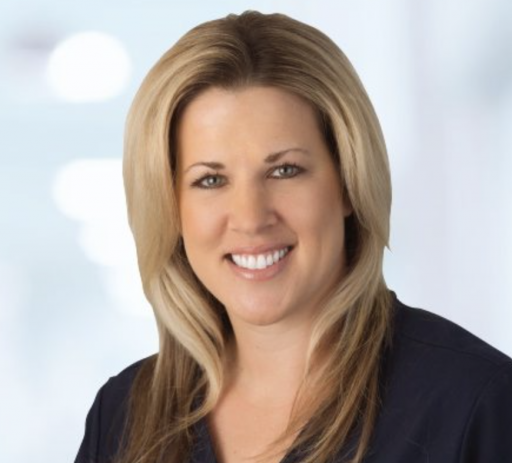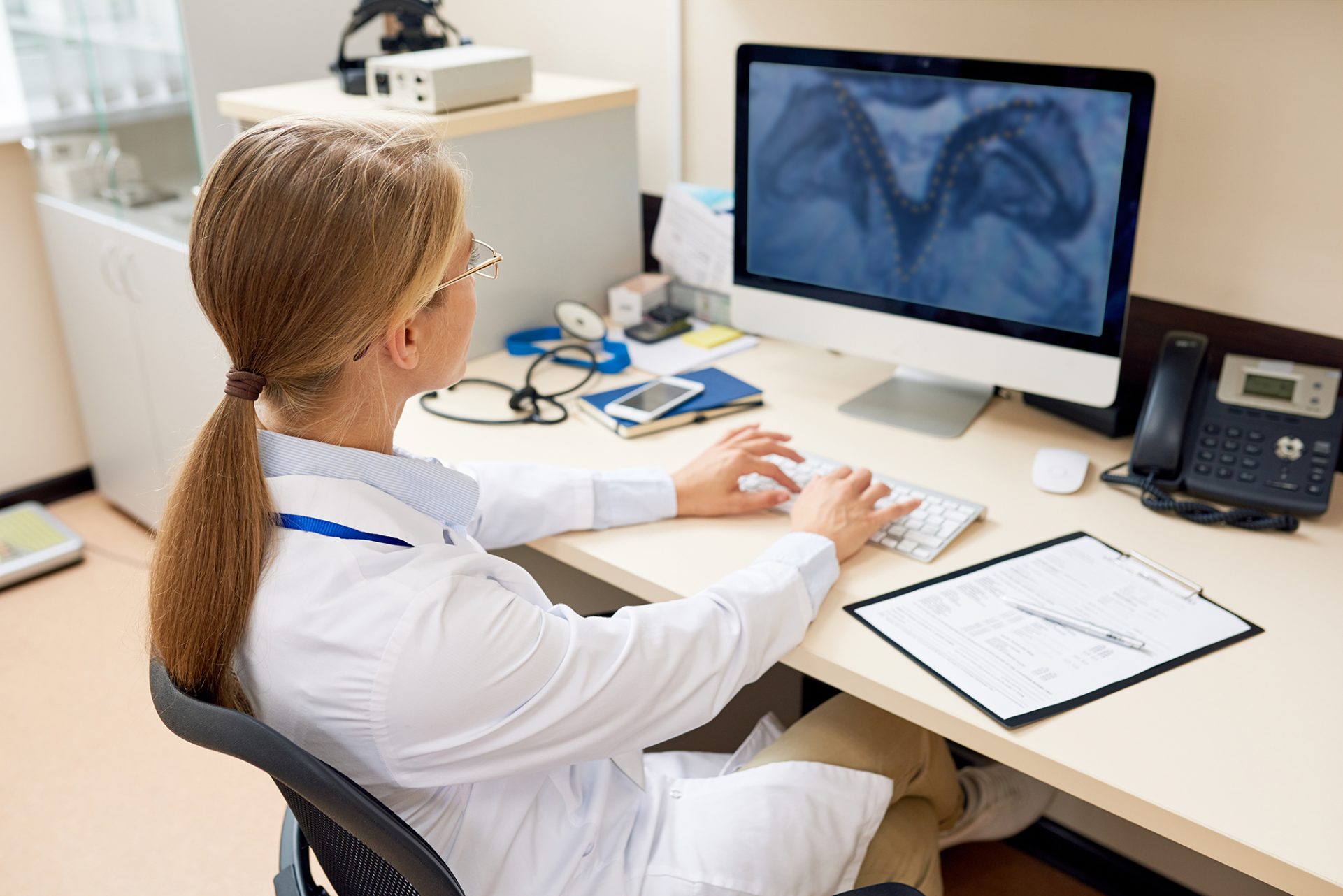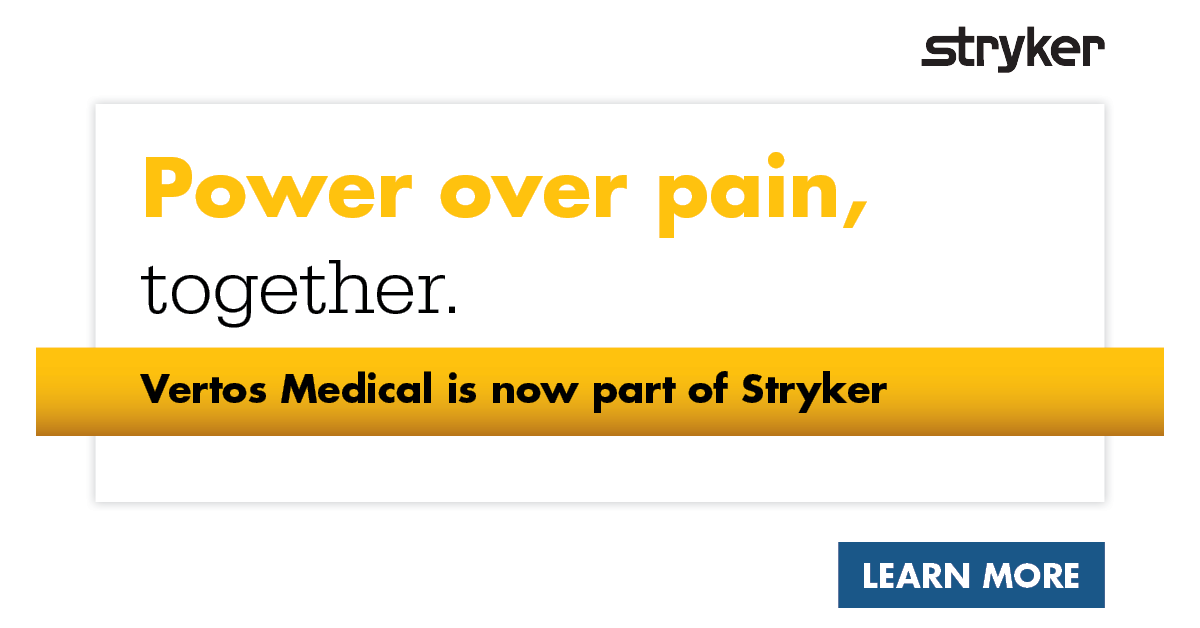How Dr. Lindsay Shroyer Moved Forward with mild® in Her Practice
Published March 17, 2021
The buzz of the minimally invasive lumbar decompression procedure known as mild® to treat lumbar spinal stenosis (LSS) circled around Dr. Lindsay Shroyer for years. It began with her Pain Medicine Fellowship in 2011-2013 and continued when she would attend conferences for the American Society of Interventional Pain Physicians (ASIPP) and Florida Society of Interventional Pain Physicians (FSIPP), with interventional professionals, like Dr. Ramsin Benyamin, speaking about it. Finally, after learning of its arrival in Florida and that her two friends and colleagues, Dr. Navdeep Jassal—a Fellow from the University of South Florida—and Dr. Danya Godoy-Hung were utilizing the mild® Procedure, Dr. Shroyer made the move to adopt the mild® Procedure into her practice.
A mild® and Convenient Training
After being put in contact with a local Vertos Medical mild® Procedure representative, Dr. Shroyer attended a Vertos-led training to learn how to identify and treat the right patients, establish comfort and clinical efficiency, and truly redefine the way she approached treating her patients with lumbar spinal stenosis.
What was your experience like training for the mild® Procedure?
It was really nice and convenient! I was able to watch videos about the procedure beforehand and use a fluoroscopic bone model, so I could visualize the procedure and had an idea of what it would feel like prior to the training. Sometimes trainings can feel overwhelming – like when I did my first cervical epidural in fellowship, my heart was pounding in my ears because I was so nervous! With the mild® Procedure, it didn’t seem like something I couldn’t accomplish as the learning curve was really doable. I left the training understanding the landmarks and felt really comfortable.
What advice would you offer somebody getting trained with mild®?
The two aspects of the learning curve to keep in mind are one: the confidence of being able to use a new view (the contralateral oblique view) to precisely access the designated space and two: mastering the technique of using the tissue sculptor to really ensure you get the material out. Remember that it’s okay to establish comfort knowing that you’re erring on the side of caution, that this is an extremely safe approach and that you will get to the point where you are comfortably using the specialized mild® tools and making them work for you.
The Oblique View: A Rewarding Challenge
With a low-risk profile equivalent to an epidural steroid injection (ESI), the mild® Procedure requires no general anesthesia, implants, stitches or opioids and can be performed through a single, tiny incision under still- and live-image fluoroscopic guidance. We spoke to Dr. Shroyer on the learning curve that this may involve.
Can you tell us more about the doable learning curve that you mentioned?
I think the most challenging part about learning how to do the mild® Procedure was thinking in a contralateral oblique view, because I trained in AP and lateral view for my epidurals and when you’re eyes aren’t used to telling your hands it’s okay to work in that dimension, it can make it hard to trust and move forward.
How were you able to solve that challenge?
I was able to combat that feeling by practicing and cross-referencing every lumbar epidural injection I would do with the contralateral oblique view. First I did the AP and then the lateral to confirm. Then, I would look at the oblique and see where my needle was. Later, I started doing them in the oblique and had my x-ray tech place the C-arm in the oblique view to forty/forty-five degrees and make sure I could see my landmarks. Now that oblique view helps me with cervical epidurals. It’s really improved my skill and confidence performing an epidural at any level, which I’ve been doing for many years!
What was your trajectory like to establish efficiency with the mild® Procedure?
My first day I had maybe three or four mild® cases. After my second or third set of cases, I was performing the procedure efficiently and was more confident. I started with the “easier” cases, as in patients without previous surgeries, and less severe cases of stenosis. Those more complicated cases took a little bit longer, but they’re what make the others seem easier! I also began carefully tracking the time it took me to perform cases as I grew more and more comfortable with the predictability of mild® so I knew how much time to book at the surgery center.*
*A recent device intensive indication increased national ASC profit margin average by 41%, which will increase patient access to the mild® Procedure. Learn more.
Adopting the mild® Procedure into Your Practice
Adding mild® to a practice goes beyond clinical comfort. To optimize care for the millions of patients suffering with lumbar spinal stenosis, it is critical to define a practice-specific approach to patient identification, education, establishing expectations and assessing outcomes. Dr. Shroyer shares her insights on how mild® can easily be implemented and the role of other healthcare professionals in the practice.
Can you share a little bit about the process of adopting mild® into practice?
So much of it is being attuned to your patient population. I treat an aging patient population and many of my patients have various levels and severities of lumbar stenosis. Historically these patients received epidural steroid injections. mild® provides me the option to address the root cause of LSS and move beyond ESIs, so staff education and training was critical to getting my practice set up to appropriately manage these patients and to optimize their care. The good news is, identifying these patients is simple. Neurogenic claudication, often known as the shopping cart syndrome, is easy to spot! When you watch patients walk down the hallway, you can see them coming a mile away.
How would you recommend approaching the mild® Procedure when it comes to office staff, advanced practice providers (APPs), etc.?
I partnered with our Vertos rep and we spent a lot of time educating our entire staff and that really helped to have an additional person explain things and support staff education. It comes down to perspective – reminding everyone that many of our patients are candidates and to become attuned and extremely observant of the signs. Encouraging them to ask the patient specific questions like, “How many blocks can you walk without pain?” To review the actual MRI themselves to look for the ligament, instead of relying on the radiology reports. There are so many patients that have stenosis that benefited from mild®, now it’s easy to see a patient and say, “Oh, you’re a great candidate for this!”
How has mild® impacted you as a physician?
It’s nice to have a new procedure to be excited about. I feel like it’s been such a huge change to my practice to be able to offer it to patients with stenosis that didn’t have a path before. There is excellent data to support the procedure, and I’ve personally seen positive results with my patients. If you can provide a good alternative to surgery, it’s worth a try.
Do you like doing the procedure?
Yes I do! It’s rewarding. You can see the ligament and tissue as you’re removing it in the OR, you can tell the patient beforehand what to expect and what to see. When you do the procedure and you’re fighting through a really osteophytic back and you finally just kind of break through and get further, it’s that feeling of knowing that this is going to relieve their pain. I really like having that ability.
Making a Major Impact on Patients
After recently hitting a 100-case milestone, Dr. Shroyer described her experience with the mild® Procedure as ‘simple and easy.’ She was excited to share the ways in which mild® has contributed to her patient success.
How do you introduce your patients to the mild® Procedure?
I look at the MRI every time I see a patient and I pull it up and show them that way they understand what it is I’m trying to accomplish. In that way, it helps establish trust. They usually walk away saying, “Oh, nobody has ever shown that to me. Now I see what you’re doing.”
Is there a specific way that you describe mild® to them?
While I have their imaging up, I show them what normal looks like and then I show them what their MRI looks like. I explain to them that their stenosis is like a water hose. When you squeeze or kink the hose, water doesn’t get through and that it’s similar to their case, which causes pain. I explain that my goal is to try to open that space up to improve that pain, just as you would take pressure off a water hose to increase the flow.
How is this typically received by the patients?
The mild® Procedure is easy to bring to a patient. No wires or implants to manage, there is low risk of infections, and it works. I tell them that the risks are less than one percent, along with showing them where their spinal cord is in the MRI and explain that the procedure is below the level of the spinal cord. I tell them that from my own experience, complications are minimal, and when I show them I’m not near a major anatomical structure, they’re very comfortable moving forward.
What have your patient outcomes been like?
It’s probably about 50% improvement on the first week. I explain that the patient may be sore the first few days after the procedure. I have patients follow up with me 1 week post procedure. At that time, I examine the patient, and I prescribe physical therapy to rebuild their strength. I usually have them back in my office a month after that. We’ve seen about 80% improvement with walking and function. I also manage their expectation of the procedure by explaining that it’s going to improve the stenosis, but it may not improve the facet joint pain or other issues they may have.
Do you have a favorite mild® patient story you’d like to share?
I do! One of my patients has been with me since 2014. I did mild® on her and she’s really relieved. She has about 80% relief from the mild® Procedure. She’s sleeping better, she’s more comfortable, she’s just super happy. I’ve had a few patients that mild® just knocked it out of the park for them and they’re happier in life.
Dr. Shroyer has been able to consistently help numerous patients monthly achieve lasting relief with the mild® Procedure. It was an honor to speak with her and discover the impact she’s been able to make in her patients’ lives using mild®. Learn more about how mild® can help your LSS patients get moving this year.

About Dr. Lindsay Shroyer
Lindsay Shroyer, MD, is an Interventional Pain Physician with a Fellowship in Pain Medicine from the University of South Florida and board certifications in Pain Medicine, and Physical Medicine and Rehabilitation. She completed a Residency in Physical Medicine and Rehabilitation at the University of Kentucky College of Medicine and received her Doctor of Medicine from Ross University School of Medicine. Dr. Shroyer is a member of the American Society of Interventional Pain Physicians (ASIPP) and Florida Society of Interventional Pain Physicians (FSIPP).
This interview with Lindsay Shroyer, MD, has been condensed for length and clarity. The views and opinions expressed in this article are those of the speaker and do not necessarily reflect the official policy or position of Vertos Medical.

